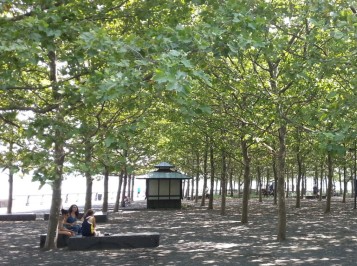More trees provide essential protections as our cities and the world is threatened by rising temperatures

The last significant addition to Hoboken tree canopy coverage was at Hoboken’s South Waterfront in the 1990s.
FBW | August 14, 2023
According to Google’s Environmental Insights Explorer (EIE), 13 percent of Hoboken is covered by its tree canopy. The U.S. average canopy coverage for urban areas is 27 percent. New York City’s is below average at 19 percent. Pittsburgh, Pennsylvania ranks among the highest with 44 percent.
Extreme and alarming weather conditions around the globe have focused attention on trees, especially canopy trees, as an essential tool in dealing with heat, pollution, stormwater and climate change. A city’s tree canopy can have a major impact and provides a natural, economical means of responding to the problem.
Most of Hoboken’s existing tree canopy was established in an earlier era at Church Square, Stevens, Elysian and Columbus Parks, all built more than 100 years ago. In the 1990s, hundreds of shade trees were planted at Hoboken’s South Waterfront, garnering recognition from the American Society of Landscape Architects. This landscape design included a grove of London plane trees at Pier A Park and multiple rows of London plane trees and Chinese elms along the walkway from Newark to Fourth Street.
In the past 20 years, Hoboken has undertaken an ambitious program to build more parks focusing on the western part of town but has failed to make shade trees a priority. Along the waterfront, Castle Point Park is a barren landscape and Maxwell Place Park includes an expanse of concrete at the north end devoid of trees. FBW’s recent proposal for a greenway along Fifteenth Street was rejected by the City. (See link below.)
A study recently published in Nature Medicine determined that nearly 62,000 people died in heat-related deaths in Europe last summer between May 30 and September 4. The countries near the Mediterranean Sea: Italy, Greece, Spain and Portugal, recorded the highest mortality rates.
The Lancet published research showing that increasing tree cover to 30 percent, in effect doubling the existing coverage, could reduce heat-related deaths in European cities by 40 percent.
The July 2023 heatwave has been sending temperatures in parts of the world into triple digits for prolonged periods breaking records in Mexico, the U.S. Southwest, Southern Europe and China. Phoenix, Arizona recorded temperatures over 110 degrees every day from June 30 to July 30, dropping to 108 degrees on the 31st of July.
The rays of the sun heat up a city’s roadways, sidewalks and rooftops. The cars, buses and trains generate yet more heat. As temperatures rise, air conditioners pump even more warm air into the outdoors. The result of all this has been called the heat island effect. For urban dwellers, which includes 80 percent of the U.S. population, the heat island effect can increase temperatures by 8 degrees Fahrenheit or more.
For planet Earth, the temperatures for June were the hottest on the record books. July is likely to follow suit. 2023 is shaping up to be the hottest year on record. The past eight years have all been the hottest ever recorded.
Shade trees are a critical component of a city’s infrastructure. In addition to their aesthetic value and ability to lower temperatures, they provide many other benefits. Through photosynthesis, shade trees sequester carbon dioxide and provide oxygen, essential to human life. Large trees also have the capacity to take up significant volumes of water, thus reducing storm-water runoff. They also are able to remove pollutants from the air, including carbon monoxide, nitrogen dioxide, sulfur dioxide and particulate matter, thus improving air quality and creating a healthier environment. Trees contribute significantly to the energy efficiency of buildings.
Related Articles
Roots Over the River – Landscape Architecture
Sustainable trees for sustainable cities – Arnoldia
Related Links
On Arbor Day, taking inventory of Hoboken’s canopy trees
Our proposal for a public greenway along 15th Street
A green + blue vision for Union Dry Dock
An innovative planting technique for urban trees
Making the “green circuit” greener along Hoboken’s waterfront
An opportunity to upgrade the long neglected central waterfront
Hoboken’s model for trees in urban design
In praise of London plane trees in London . . . and in Hoboken
The transformation of Hoboken’s waterfront
Mapping New York City’s trees

